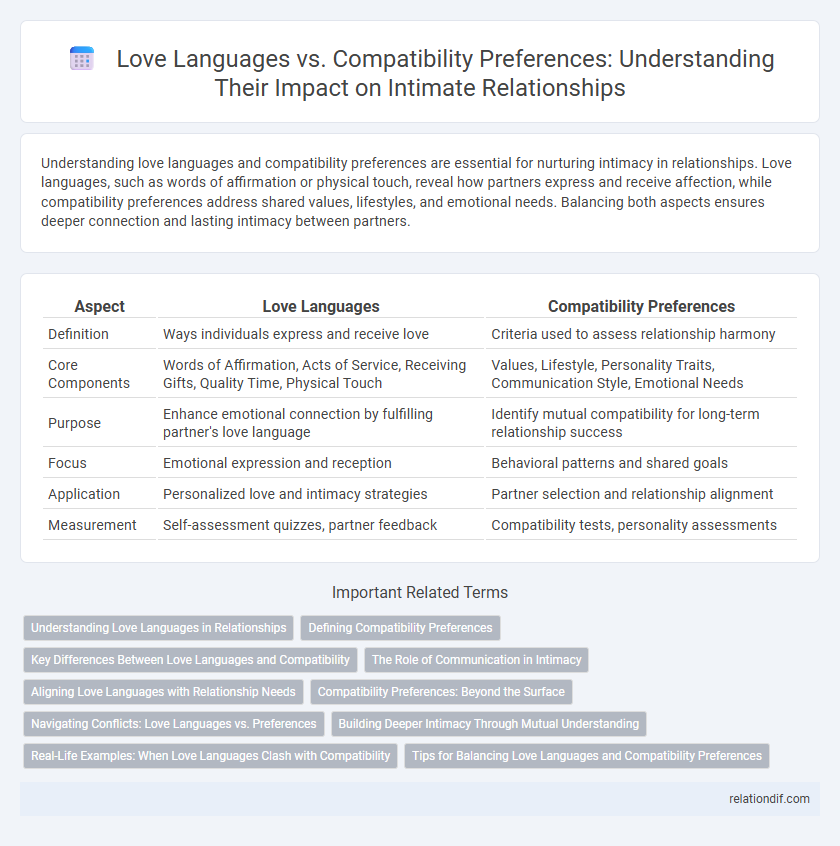Understanding love languages and compatibility preferences are essential for nurturing intimacy in relationships. Love languages, such as words of affirmation or physical touch, reveal how partners express and receive affection, while compatibility preferences address shared values, lifestyles, and emotional needs. Balancing both aspects ensures deeper connection and lasting intimacy between partners.
Table of Comparison
| Aspect | Love Languages | Compatibility Preferences |
|---|---|---|
| Definition | Ways individuals express and receive love | Criteria used to assess relationship harmony |
| Core Components | Words of Affirmation, Acts of Service, Receiving Gifts, Quality Time, Physical Touch | Values, Lifestyle, Personality Traits, Communication Style, Emotional Needs |
| Purpose | Enhance emotional connection by fulfilling partner's love language | Identify mutual compatibility for long-term relationship success |
| Focus | Emotional expression and reception | Behavioral patterns and shared goals |
| Application | Personalized love and intimacy strategies | Partner selection and relationship alignment |
| Measurement | Self-assessment quizzes, partner feedback | Compatibility tests, personality assessments |
Understanding Love Languages in Relationships
Understanding love languages enhances relationship intimacy by identifying how partners express and receive affection, such as through words of affirmation, acts of service, or physical touch. Compatibility preferences influence how effectively these love languages align, affecting communication and emotional connection. Prioritizing mutual recognition of love languages fosters deeper empathy and strengthens relationship bonds.
Defining Compatibility Preferences
Compatibility preferences refer to the individual traits and values that determine how well partners align in a relationship, such as communication styles, emotional needs, and lifestyle choices. These preferences influence relationship satisfaction by shaping how partners interact beyond just their love languages, which focus primarily on expressions of affection. Understanding compatibility preferences helps couples identify areas of harmony and potential conflict, fostering deeper intimacy and long-term connection.
Key Differences Between Love Languages and Compatibility
Love languages describe how individuals express and receive affection, categorizing into five types: words of affirmation, acts of service, receiving gifts, quality time, and physical touch. Compatibility preferences involve broader relational factors such as values, lifestyle choices, communication styles, and conflict resolution methods that influence the overall harmony between partners. While love languages target emotional connection through specific behaviors, compatibility determines long-term relationship success by aligning core beliefs and personal habits.
The Role of Communication in Intimacy
Effective communication is essential in navigating love languages and compatibility preferences within intimacy, as it allows partners to express their emotional needs clearly and understand each other's unique ways of giving and receiving love. By openly discussing personal preferences and feelings, couples can bridge potential gaps in affection, fostering deeper connection and mutual validation. This ongoing dialogue strengthens trust and helps tailor relationship dynamics to honor both partners' emotional expressions.
Aligning Love Languages with Relationship Needs
Aligning love languages with relationship needs enhances emotional connection and fosters mutual understanding between partners. Recognizing each other's primary love languages--such as words of affirmation, acts of service, or physical touch--helps tailor expressions of affection to resonate deeply. Compatibility preferences are strengthened when love languages are actively incorporated, ensuring that both partners feel valued and fulfilled.
Compatibility Preferences: Beyond the Surface
Compatibility preferences delve deeper than love languages by addressing core values, lifestyle choices, and emotional needs that shape relationship dynamics. Understanding these preferences helps partners align on long-term goals and navigate conflicts effectively, fostering a resilient connection. Compatibility influences intimacy by ensuring both individuals feel understood and supported beyond verbal expressions of love.
Navigating Conflicts: Love Languages vs. Preferences
Navigating conflicts between love languages and compatibility preferences requires understanding that love languages represent emotional expression, while preferences reflect deeper values and lifestyle choices. Couples who prioritize empathetic communication and active listening can bridge the gaps between differing expressions of love and personal needs. Recognizing and validating both love languages and compatibility preferences fosters emotional resilience and long-term relationship harmony.
Building Deeper Intimacy Through Mutual Understanding
Love languages and compatibility preferences play crucial roles in building deeper intimacy by fostering mutual understanding between partners. Recognizing each other's preferred ways of expressing and receiving love, such as words of affirmation, physical touch, or acts of service, enhances emotional connection and reduces misunderstandings. Prioritizing awareness of these individual differences cultivates a supportive environment where both partners feel valued and emotionally secure.
Real-Life Examples: When Love Languages Clash with Compatibility
When love languages clash with compatibility preferences, misunderstandings often arise, such as a partner valuing physical touch while the other prioritizes acts of service, leading to feelings of neglect despite genuine affection. Real-life examples reveal couples struggling to express love effectively; one partner may feel unappreciated when their preferred language isn't reciprocated, causing tension and emotional disconnect. Addressing these differences through open communication and adapting to each other's love languages can bridge compatibility gaps and strengthen intimacy.
Tips for Balancing Love Languages and Compatibility Preferences
Balancing love languages and compatibility preferences requires open communication to understand each partner's emotional needs and boundaries clearly. Prioritize active listening and empathy to recognize how different expressions of love align with deeper compatibility factors, such as values and lifestyle choices. Regularly revisiting and adjusting these dynamics fosters a healthy, resilient relationship grounded in mutual respect and affection.
Love Languages vs Compatibility Preferences Infographic

 relationdif.com
relationdif.com